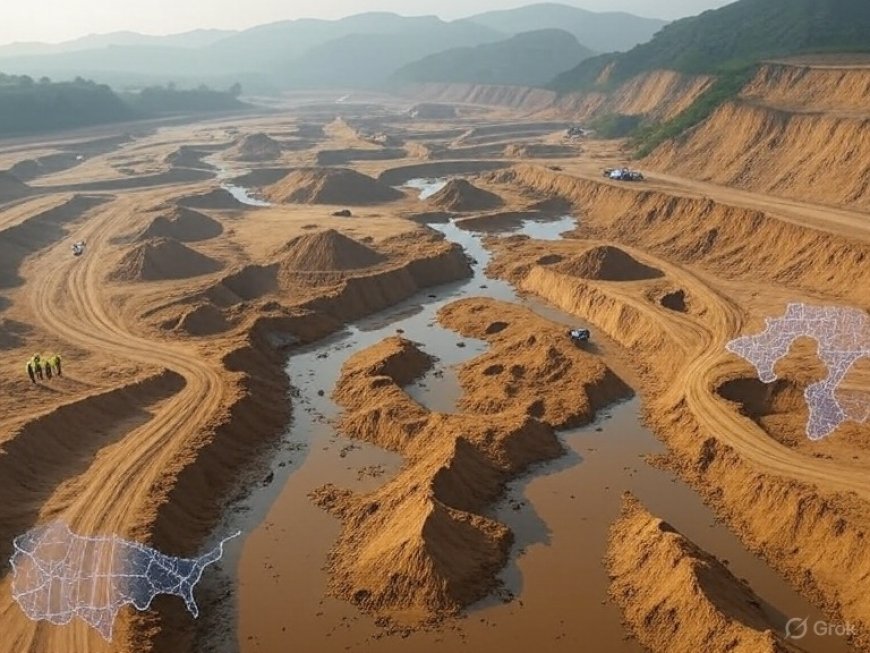Haryana’s ₹10.7 Crore Blow to Illegal Mining: Tech-Driven Crackdown Raises Bar on Environmental Enforcement
Haryana's mining crackdown uses drones, AI, and satellite tech to fine violators ₹10.7 crore in 2025, setting new benchmarks in environmental enforcement.

In a landmark move towards sustainable resource governance, the state of Haryana has imposed fines totaling ₹10.7 crore in a sweeping crackdown on illegal mining activities. The operation, which has gained national attention, was powered by a robust mix of drone surveillance, satellite imagery, and real-time data analytics—making it one of India’s most tech-intensive environmental enforcement drives to date.
This decisive action sends a strong signal to violators that mining without licenses, especially in environmentally sensitive zones, will no longer go unchecked. It also sets a model for other states grappling with the twin challenges of ecological degradation and poor regulatory oversight.
High-Tech Surveillance Meets Traditional Enforcement
Haryana’s Department of Mines and Geology has long struggled with rampant illegal mining, particularly in districts like Yamunanagar, Karnal, and Faridabad. However, 2025 marked a sharp pivot in strategy.
Instead of relying solely on field inspections and complaints, authorities partnered with the Haryana Space Applications Centre (HARSAC) and integrated satellite-based monitoring systems. In addition, over 40 drones were deployed to capture aerial footage of suspected mining hotspots—especially in the Aravalli foothills and riverbeds of northern districts.
These technologies enabled rapid identification of illegal mining sites, followed by swift ground-level enforcement involving the state police, forest officials, and mining officers.
Breaking Down the ₹10.7 Crore Penalties
Between April and July 2025, authorities registered over 370 cases of illegal mining. The cumulative fines imposed on contractors, vehicle owners, and middlemen touched ₹10.7 crore—an all-time high for the state within a single quarter.
-
Sand mining in unauthorized riverbeds accounted for nearly 60% of cases.
-
Excess excavation beyond lease limits was another key violation.
-
Unauthorised transport of minerals without proper documentation was also penalized.
The crackdown targeted both large-scale operators and smaller cartels that had thrived due to regulatory loopholes and alleged collusion at local levels.
Political and Legal Implications
The mining crackdown is not just an environmental issue; it carries significant political weight. Illegal mining has often been linked to funding local political campaigns, and past efforts at reform have met with resistance.
However, the current Bharatiya Janata Party (BJP)-led state government, under Chief Minister Nayab Saini, appears committed to making enforcement a priority in the lead-up to the 2025 civic body elections.
The government has promised to bring amendments to the Haryana Minor Mineral Concession Rules, introducing harsher penalties, mandatory drone audits, and a public-facing dashboard tracking mining leases and violations.
Furthermore, legal proceedings have already been initiated in at least 120 cases under the Mines and Minerals (Development and Regulation) Act, with 22 FIRs registered for repeated violations. A few cases are also being referred to the Enforcement Directorate (ED) for suspected money laundering.
Impact on Environment and Water Resources
Illegal mining, particularly sand and gravel extraction, has had devastating consequences on Haryana’s ecology. Riverbeds have been left scarred, aquifers depleted, and biodiversity disrupted.
In Yamunanagar district, unscientific mining near the Yamuna River has contributed to riverbank erosion, threatening nearby agricultural zones. Similarly, parts of Mewat and Gurugram have witnessed destruction of Aravalli hillocks, exacerbating desertification and impacting groundwater recharge.
By clamping down with precision, the state is not only safeguarding natural resources but also laying the groundwork for sustainable extraction practices.
The Technology Edge: Haryana as a National Model
The successful implementation of surveillance tech has garnered attention from other Indian states. Several state officials from Rajasthan, Uttar Pradesh, and Madhya Pradesh have reportedly reached out to Haryana’s mining department for collaboration and training in GIS mapping and automated violation tracking.
Key technologies utilized include:
-
Drone-based LIDAR scans to detect excavation depths
-
Geotagged inspection reports via mobile apps used by ground staff
-
Real-time satellite data from HARSAC integrated with AI-powered anomaly detection
This tech-enabled model ensures not only detection but also traceability—making it harder for repeat offenders to exploit administrative delays or political influence.
Public Participation and Transparency
A new development in this campaign has been the launch of a public grievance redressal portal, where citizens can upload photos or videos of suspicious mining activity. The state has received over 500 such complaints in the past two months, many of which have resulted in enforcement action.
Additionally, Haryana is planning to release a quarterly mining transparency report, outlining total fines, licenses issued, public complaints received, and enforcement metrics.
This push for transparency is a rare but welcome move in a sector historically marred by opacity and informal dealings.
Criticism and Road Ahead
Despite the campaign’s success, there have been criticisms. Several transport associations have protested what they call “excessive policing,” alleging that genuine mineral transport is also being harassed.
Mining unions have demanded clearer guidelines and better awareness among enforcement agencies to differentiate between legal and illegal operations.
In response, the Mines Department has promised to set up nodal officers in each district to assist transporters and ensure that legitimate business is not disrupted.
Long-term, the state is also considering auctioning mining leases only through e-bidding and tying them to environmental impact compliance reports.
Conclusion: Environmental Accountability Takes Root
Haryana’s ₹10.7 crore crackdown on illegal mining is more than just a collection drive—it’s a statement of intent. In an era where natural resources are being depleted at unprecedented rates, the use of cutting-edge technology for environmental enforcement sets a powerful precedent.
By turning enforcement into a data-driven, transparent process, Haryana has shown that sustainable development and economic growth need not be mutually exclusive.
If this momentum continues, the state could serve as a template for other regions battling illegal resource extraction, and push India closer toward its environmental and developmental goals.


















































